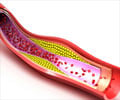
"Anything that lowers amyloid-beta production should help prevent, or possibly treat, Alzheimer's disease," Sanders said.
Amyloid-beta production requires two "cuts" of the APP protein. The first cut, by the enzyme beta-secretase, generates the C99 protein, which is then cut by gamma-secretase to release amyloid-beta. The Vanderbilt researchers used nuclear magnetic resonance and electron paragmagnetic resonance spectroscopy to determine the structure of C99, which has one membrane-spanning region.
They were surprised to discover what appeared to be a "binding" domain in the protein. Based on previously reported evidence that cholesterol promotes Alzheimer's disease, they suspected that cholesterol might be the binding partner. The researchers used a model membrane system called "bicelles" (that Sanders developed as a postdoctoral fellow) to demonstrate that C99 binds cholesterol.
"It has long been thought that cholesterol somehow promotes Alzheimer's disease, but the mechanisms haven't been clear," Sanders said. "Cholesterol binding to APP and its C99 fragment is probably one of the ways it makes the disease more likely."
Sanders and his team propose that cholesterol binding moves APP to special regions of the cell membrane called "lipid rafts," which contain "cliques of molecules that like to hang out together," he said.
Advertisement
Source-Eurekalert















